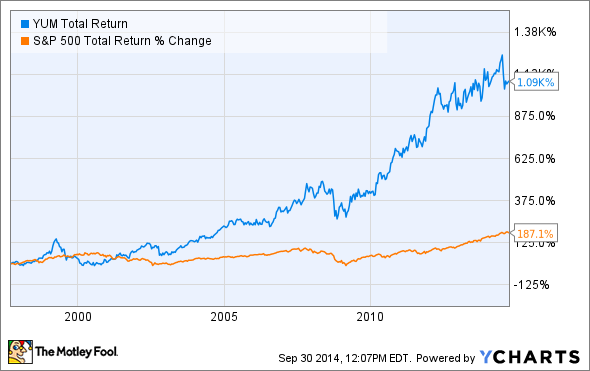Filed under: Investing
To no one's surprise, the new, larger phones from Apple have been a smashing success. With over 4 million units pre-sold in the first 24 hours, and 10 million the first weekend, it seems Apple's setting new sales records daily, and that's saying something. Both phones sport larger screen sizes -- the iPhone 6's display measures 4.7 inches, while the iPhone 6 Plus is officially phablet-sized with its 5.5 inch retina screen.
It wasn't that long ago Apple CEO Tim Cook went on record stating he had no intention of going down the phablet path. Thankfully for iFans, that's changed, and it appears Cook's about-face was a sound business decision for investors. How many of the 10 million units sold the first weekend were of the phablet variety we can only speculate, but based on lead times -- how long, on average, it's taking Apple to fill orders -- the company's phablet is a rousing success. Though challenges remain, look no further than industry-leading Samsung , according to new research from Adobe, Apple can expect the iPhone 6 Plus to continue flying off the shelves.
The good news
Though it hasn't happened as quickly as some industry pundits expected, the market for phablets is expected to explode. In the next five years, should the estimates prove correct, phablets will occupy an impressive 59% of the smartphone market, grow at twice the annual rate as "old-school" smartphones, and sell 1.5 billion units in 2019. Assuming growth expectations are even close, Cook really didn't have an option but to introduce Apple's first phablet to the world.
As impressive as the phablet market growth estimates are, Adobe's research may be an even better indication of why the iPhone 6 Plus is going to change the smartphone landscape. In the U.S., Apple's bread-and-butter market, a whopping 54% of all smartphone web traffic comes from Apple devices. Apple's chief smartphone manufacturing competitor, Samsung, is a distant second with a mere 24%.
What makes Adobe's smartphone web traffic stats even more impressive is as of July of this year, Apple's iOS commands "just" 42.4% of the U.S. market, while Android, thanks in large part to Samsung, runs 51.5% of the domestic smartphone operating systems. In other words, though Apple has fewer users, it drives a majority of smartphone web traffic.
Clearly, iFans like to use their smartphones for a great deal more than making and receiving calls: Their iPhones are truly mobile devices. If iPhone users are as comfortable accessing the web via their devices as Adobe's research suggests, it stands to reason they'd really enjoy their online experience on a larger screen phablet, like the iPhone 6 Plus. Also, when you factor in the proliferation of streaming videos like YouTube, movies, and games, the case for an explosion of Apple phablet sales really picks up steam.
As always, there are challenges
Overblown or not, Apple fans don't need to be reminded of what some are calling, "bendgate," the notion that the new iPhones, particularly the iPhone 6 Plus, are prone to bending. Or, the short yet rather embarrassing cellular outage miscue as a result of a faulty iOS download. Some have also complained about the iPhone 6 and iPhone 6 Plus less-than-ideal battery life.
But the biggest challenge to Apple's phablet ambitions lies with a familiar nemesis: Samsung. There's little doubt, based on Adobe's data and the fanaticism of Apple's users, that many of those folks using their existing iPhones to access the Internet will take a look at its new phablet. But what about converting the over 51% of U.S. smartphone owners who own an Android OS device? Or the nearly 85% of smartphone users worldwide that utilize an Android OS, many of which were built by Samsung? For Apple to really dominate phablets, it will need to appeal to at least some portion of the non-iOS market.
Final Foolish thoughts
Converting current iPhone owners to its new phablet already appears to be an unmitigated success, and taking Adobe's mobile online data into account, that's likely to continue. In what is expected to be an exploding market, Apple's new phablet is going to command a big piece of a huge pie. Challenges? Of course, with an expected 1.5 billion units sold in 2019, any company that builds a smartphone will soon bring its own phablet into the fray, if it hasn't already. But if the U.S. smartphone web access numbers are any indication, the iPhone 6 Plus could end up being the dominant player.
Warren Buffett's worst auto-nightmare (Hint: It's not Tesla)
A major technological shift is happening in the automotive industry. Most people are skeptical about its impact. Warren Buffett isn't one of them. He recently called it a "real threat" to one of his favorite businesses. An executive at Ford called the technology "fantastic." The beauty for investors is that there is an easy way to ride this megatrend. Click here to access our exclusive report on this stock.
The article Why the Apple iPhone 6 Plus Will Be a Success originally appeared on Fool.com.
Tim Brugger has no position in any stocks mentioned. The Motley Fool recommends Adobe Systems and Apple. The Motley Fool owns shares of Apple. Try any of our Foolish newsletter services free for 30 days. We Fools may not all hold the same opinions, but we all believe that considering a diverse range of insights makes us better investors. The Motley Fool has a disclosure policy.Copyright © 1995 - 2014 The Motley Fool, LLC. All rights reserved. The Motley Fool has a disclosure policy.
Read | Permalink | Email this | Linking Blogs | Comments






































